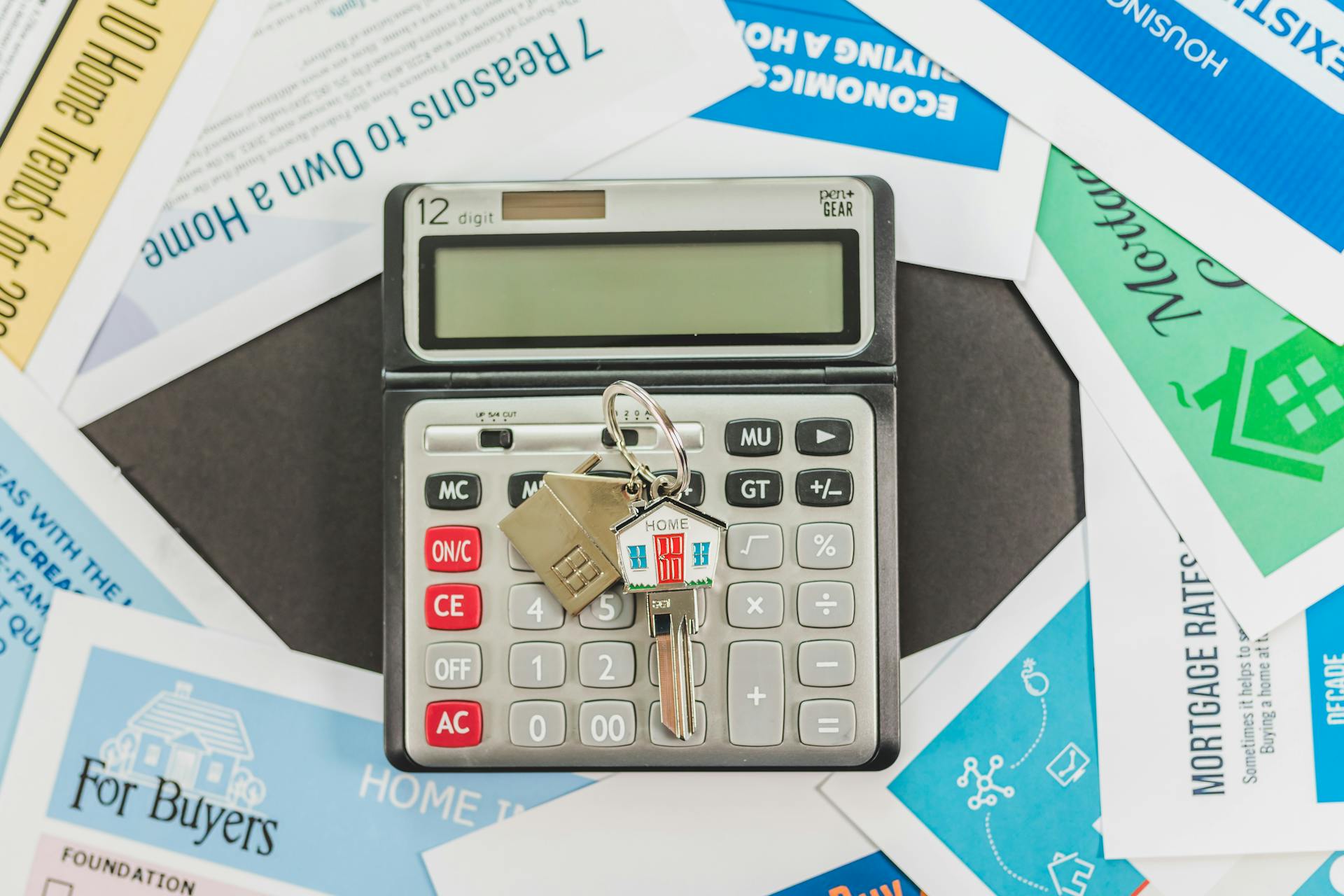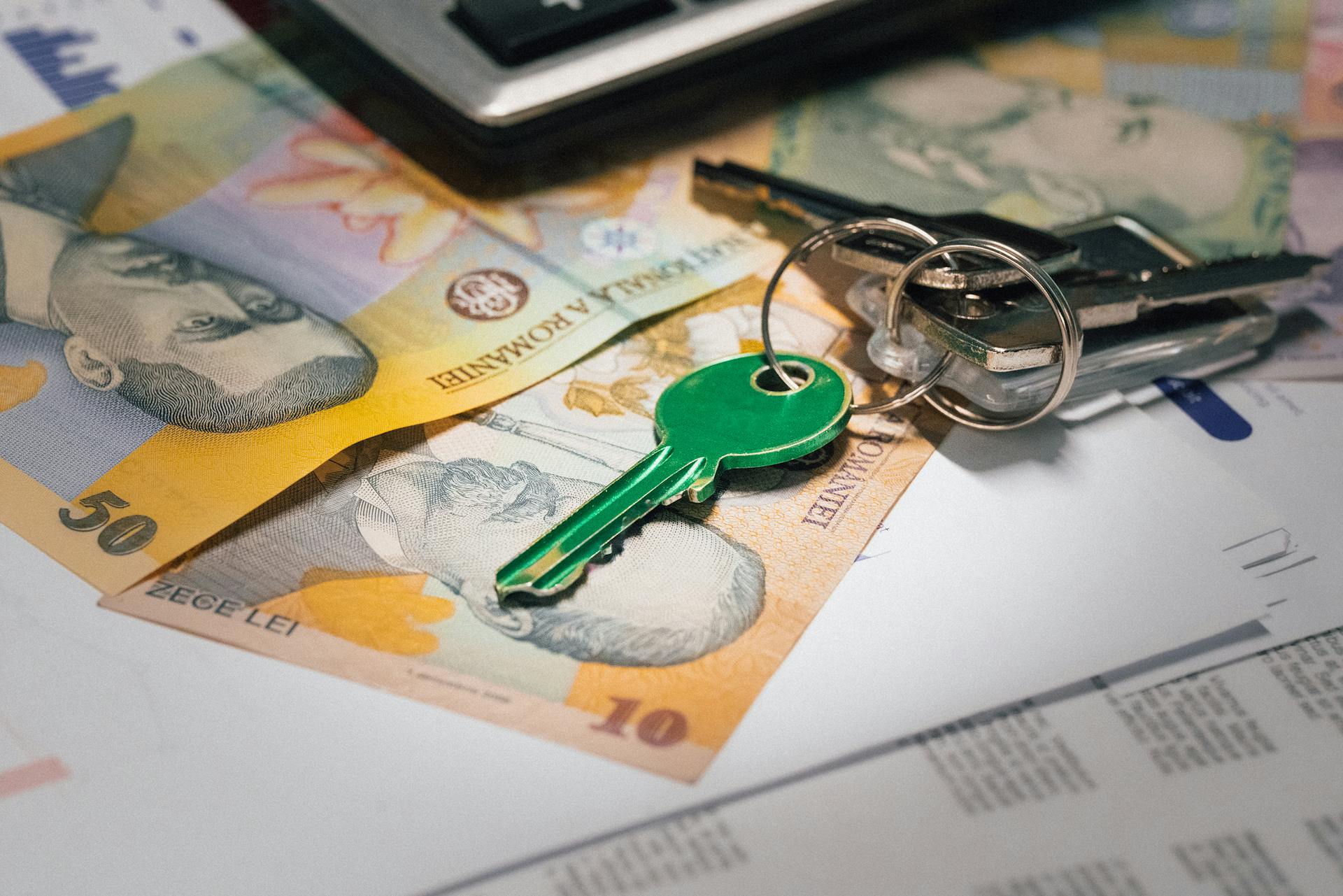
Getting started with a home improvement mortgage loan can seem daunting, but it's easier than you think. There are several types of home improvement mortgage loans available, including FHA Title 1 loans and Home Equity Conversion Mortgages (HECMs).
FHA Title 1 loans are a good option for homeowners who need to finance repairs or improvements. They offer loan amounts up to $25,000 with low interest rates and no prepayment penalties.
Homeowners who are 62 or older may be eligible for a HECM, which allows them to tap into their home's equity to fund renovations. The loan amount is determined by the appraised value of the home.
The Federal Housing Administration (FHA) insures these loans, making them a more attractive option for borrowers.
Recommended read: Is Homeowners Insurance Required on All Mortgage Loans
Home Improvement Mortgage Loans
Home improvement mortgage loans can be a great way to finance your renovation project, but it's essential to understand your options. HomeStyle Energy provides financing for sustainable updates, such as energy-efficient appliances and solar panels, perfect for borrowers looking to conserve energy and add comfort to their home.
You can choose from various types of home improvement loans, including HomeStyle Renovation, which offers standard pricing and conventional execution, allowing loan funds to be delivered even before the project starts. This loan also provides lower interest rates compared to HELOCs and personal loans.
Home improvement mortgage loans can be used to renovate any part of your home, including bathrooms, roofs, or adding accessory dwelling units. The FHA 203(k) rehab loan is another popular option, which bundles your mortgage and home improvement costs into one loan, allowing you to finance your home purchase and home improvements at the same time.
Here are some popular home improvement mortgage loan options:
- HomeStyle Renovation: Offers standard pricing and conventional execution, allowing loan funds to be delivered even before the project starts.
- FHA 203(k) rehab loan: Bundles your mortgage and home improvement costs into one loan, allowing you to finance your home purchase and home improvements at the same time.
- CHOICEReno eXPress loan: Streamlines the standard renovation process by allowing lenders to approve you for the mortgage without preapproval from Freddie Mac.
FHA 203(k) and Other Programs
The FHA 203(k) and other programs can be a great way to finance your home improvement project. The FHA 203(k) rehab loan bundles your mortgage and home improvement costs into one loan, allowing you to finance your home purchase and home improvements at the same time.
You can borrow up to 97% of the cost of buying and fixing up your home with the Fannie Mae HomeStyle renovation loan. This means you may need only a 3% down payment. Your loan amount is based on the cost of the renovation plus your purchase price or the expected value of your home after it's renovated.
The FHA 203(k) rehab loan is a great option when you're buying a fixer-upper and know you'll need funding for home improvement projects right away. These loans are also backed by the government, which means you'll get special benefits, like a low down payment and the ability to apply with a less-than-perfect credit profile.
The CHOICERenovation loan allows you to finance both the purchase (or refinance) and renovation cost of a home with a down payment as low as 3%. The loan amount is based on either the home price plus the cost of renovations, or the appraised value of the home after renovations — whichever is lower.
Here's a comparison of the FHA 203(k) and CHOICERenovation loans:
The FHA 203(k) and CHOICERenovation loans can be a bit more complicated than other loan options, but they can provide a lot of flexibility and benefits. It's worth considering these options if you're looking to finance your home improvement project.
Recommended read: Cash Advance Options
Credit Cards and Lenders
Credit cards can be a quick and easy way to finance home improvements, but they often come with high interest rates and fees. Annual percentage rates can be much higher than other financing options, making it harder to pay off the loan.
Credit card limits are often lower than home improvement budgets, requiring you to use multiple cards or apply for a higher credit limit. This can lead to a higher risk of overspending and accumulating debt.
Some credit cards offer no-interest options, but these are often promotional rates that expire after a certain period. If you're not careful, you'll be stuck with high interest rates and steep fees for late payments.
Here are some key pros and cons of using credit cards for home improvements:
- Quick and easy
- No paperwork
- No-interest options available
- Annual percentage rates are much higher than other financing options
- Credit cards limits are often lower than home improvement budgets
- Steep fees for late payments
Your credit score plays a big role in determining the interest rate you'll qualify for, especially with unsecured loans. If you have excellent credit, you'll improve your chances of getting a lower interest rate. But if you have bad credit, you'll likely face higher loan rates and fees.
Home Improvement Process
To get started on your home improvement project, you'll need to prepare the necessary documents and choose a contractor. The HomeStyle Renovation Loan Process involves several forms, including the HomeStyle Renovation "Maximum Mortgage" worksheet and the Renovation Loan Agreement.
The lender will review your documents to ensure the project meets all requirements, and you'll need to submit renovation plans to the lender. You'll also need to select a contractor and submit them to the lender.
Here's a breakdown of the Phase 1 – Preparation steps:
- Borrower selects a contractor and submits renovation plans to the lender.
- Lender reviews borrower’s documents to ensure the project meets all requirements.
- Lender orders an as-completed appraisal to assess maximum mortgage amount, check loan-to-value ratio, and calculate the loan amount.
Phase 1 - Preparation
To start the home improvement process, you'll need to go through Phase 1 - Preparation. This is where you'll select a contractor and submit your renovation plans to the lender.
The lender will review your documents to ensure the project meets all requirements. They'll also check to make sure the project is feasible and that you have a solid plan in place.
The lender will order an as-completed appraisal to assess the maximum mortgage amount, check the loan-to-value ratio, and calculate the loan amount. This appraisal will give you a clear picture of how much you can borrow and what your loan will look like.
Here's a step-by-step breakdown of Phase 1:
- Borrower selects a contractor and submits renovation plans to the lender.
- Lender reviews borrower’s documents to ensure the project meets all requirements.
- Lender orders an as-completed appraisal to assess maximum mortgage amount, check loan-to-value ratio, and calculate the loan amount.
Phase 3 - Completion
Phase 3 - Completion is the final stage of the HomeStyle Renovation process. This is where the lender takes the last look at the project to ensure everything is done correctly.
The lender will order a final inspection, and the appraiser will sign a completion certificate. This document is then provided to Fannie Mae, who will review it to ensure the project meets their standards.
Before the lender can issue the final funds, they must make sure the property has a clear title and no additional liens are on the property. This is a crucial step to protect both the lender and the homeowner.
Once the project is complete, the lender will submit the required documents to remove recourse, which is a type of liability that can be triggered if the project is not completed as agreed upon.
The lender will then close the renovation escrow account and use any remaining funds to reduce the unpaid principal balance (UPB). This means the homeowner will have a smaller mortgage to pay off.
Here's a summary of the steps involved in Phase 3 - Completion:
- Lender orders a final inspection.
- Appraiser signs completion certificate.
- Lender ensures clear title and no additional liens.
- Lender submits required documents to remove recourse.
- Lender closes renovation escrow account and reduces UPB.
Home Equity and Financing
You can refinance a home equity loan with a good credit score, sufficient home equity, stable income, a low debt-to-income ratio, and home ownership.
Home equity lines of credit and home equity loans use the borrower's property as collateral and usually provide better interest rates than other loan types.
A No Doc HELOC allows homeowners to borrow against home equity without traditional income documentation like tax returns or employment history.
You can get a no appraisal home equity loan that allows you to quickly access funds without the hassle of an appraisal.
Your credit score and report matter when applying for financing, especially for secured loans like cash-out refinances and HELOCs.
Excellent credit improves your chances of getting a lower interest rate, while bad credit will increase your loan rates significantly.
Prequalifying with online lenders can give you an estimate on your loan rates and fees without hurting your credit score.
Consider reading: Can We Get Personal Loan without Salary Slip
The money for a HELOC comes from your equity, which is the value of your home minus the amount you owe on it.
HELOCs have a draw period, usually 10 years, when you can use some or all of the funds you're approved to borrow, making them a great option for home renovation projects.
Fixer-Upper Homes and Investment
Buying a fixer-upper can be a great investment, but it's not for everyone. You may have less competition for these homes since many buyers prefer move-in ready homes.
The benefits of buying a fixer-upper include being able to customize your renovation to your liking and having the option to finance repairs with one loan, which can simplify the process.
However, renovating a home can be a significant undertaking, and you'll need to carefully consider whether you're ready to take on the challenge. Ask yourself if you know what you want, qualify for the loan, and have a plan for somewhere to live during construction.
A different take: Mortgage Loans for Mobile Homes on Land
With a fixer-upper, you may be able to build equity more quickly since these homes are often priced below move-in ready homes. But be prepared for potential cost overruns and have some wiggle room in your budget.
The FHA 203(k) program is a good option for buying a fixer-upper, as it bundles home improvement costs with your home purchase loan. However, it's essential to review the guidelines with your loan officer to ensure you understand the disbursement of fund rules.
HomeStyle Renovation loans may offer lower interest rates compared to other financing options like HELOCs and personal loans. They also allow you to renovate any part of your home, including bathrooms, roofs, or adding accessory dwelling units.
Related reading: For Individuals Who May Not Qualify for Other Mortgage Loans
Frequently Asked Questions
What is the average length of a home improvement loan?
The average length of a home improvement loan is between 5 to 15 years, considering both home equity and personal loan options. However, the actual term length may vary depending on the lender and loan type.
Sources
- https://singlefamily.fanniemae.com/originating-underwriting/mortgage-products/homestyle-renovation
- https://www.lendingtree.com/home/mortgage/buying-a-fixer-upper/
- https://www.renofi.com/h/renovation-loans/
- https://themortgagereports.com/38797/home-improvement-loans-which-is-best-for-you
- https://www.nerdwallet.com/article/loans/personal-loans/how-home-improvement-loans-work
Featured Images: pexels.com


